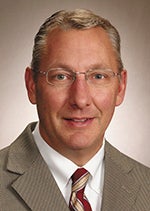‘It’s a good problem to have’ Growing APS district prioritizes facilities, operations
Published 8:43 am Wednesday, August 15, 2018
Growing enrollment numbers and classroom spacing were the most discussed items during Monday night’s school board meeting.
It comes as no surprise that Austin Public Schools experienced growing enrollment numbers within the last decade. Stotts shared that the district’s demographer projected steady, but slowing growth for students.

Mark Stotts, executive director of finance and operations
Mark Stotts, executive director of finance and operations, stated that the district had about 5,000 students enrolled at the beginning of last year, and continues to grow.
“Enrollment could be between 5,100 up to 5,400 students within the next ten years,” Stotts explained. “In the next five years, secondary schools are going to be a lot higher and there are big classes that are coming out of the elementary schools and going into the secondary schools.”
From the 2017 numbers provided by Stotts:
•There were 405 students who were in second grade
•411 students in the third grade
•434 students in the fourth grade
These three classes have the most impact on sizes and classroom spacing, according to Stotts. However, these numbers can fluctuate based on how many students return for classes in the fall.
“We grew so much, and over the next ten years it’s not unreasonable to grow at this pace,” he said. “I don’t think we’re in any danger for reduced enrollments and that’s a positive thing. More enrollment means more funding. We haven’t had to make any significant budget reductions within the last 12 years. It’s a good problem to have, but it does present some challenges.”
Growing pains
As classes continue to move ahead, the Austin School Board made a priority of focusing on facility needs of the Community Learning Center (CLC) that’s currently housed at Queen of Angels Church.
“The first priority is to find a different location for the CLC,” Stotts said. “We’ve been housed there for about 12 years. It was supposed to be temporary back then.”
Stotts described Queen of Angels as an older facility that needs “quite a bit of updating” with no backup boiler. If the boiler were to malfunction, then this could effectively shut down some of the CLC’s programs.
“There’s been issues there with water in certain areas and we’re trying to resolve those,” he said. “Just even from the technology standpoint, it’s not wired to handle the type of technology we’re dealing with now a days. …we prefer not to stay there if at all possible and move somewhere that meet our needs better. That’s our biggest priority in terms of facilities.”
Yet, the district struggled to find a place where the CLC can be housed. Either the lack of sellers willing to sell property to the district, or the property that the district looked into gets sold, or even just the cost exceeded what the district was able to afford. APS hopes to find a different solution within the next two years. If not, then the district may have to approach taxpayers with a referendum to help support a new building.
However, this was all just discussion as of now and nothing solid has been decided, Stotts stated.
“I don’t even know how many facilities we’ve looked at were either too expensive to renovate, or the seller wasn’t willing to sell or rent,” he said. “It’s been a really, really difficult challenge. We’re hoping something comes up in the next two years.”
Low on the priority list was the secondary grade spaces. Since I.J. Holton and Ellis Middle Schools had enough spacethat could accommodate the larger classes, officials turned their eyes toward a bigger concern: Austin High School.
“The high school is not going to be able to handle three classes of four hundred some students and ninth grade on top of that,” Stotts said. “We have to figure out how to free up some space, and that’s all talk right now. We haven’t got space.”
During the last school year, Austin High School had almost 1,800 students, and then an additional 75 students for the alternative learning center (ALC), which is almost at-capacity. There were some ideas tossed around during the school board meeting on whether the district office and the ALC could be moved to another location, which frees up about 13 classrooms.
APS still has four or five years to make a decision on the high school, however. The CLC comes higher on the attention-level with only two years for a choice to be made.
“This is all talk at this point, thinking out loud,” Stotts said. “We’re making the CLC our main priority and then we’ll move onto the high school. We’re always aware that if we do something like that costs are involved and our options are somewhat limited on how to finance things. Time will tell.”





